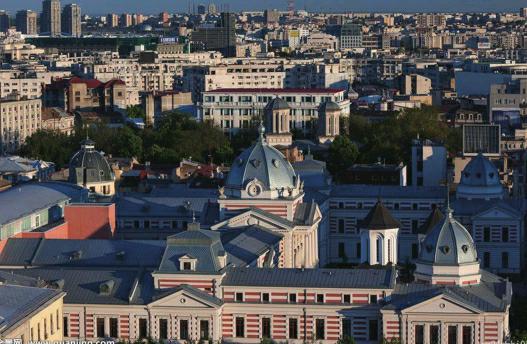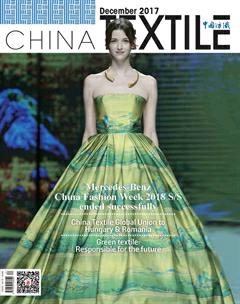Tailoring workshop in Europe-Romania
In Romania, CNTAC delegation had a deep understanding to this important Eastern European Country along “The Belt and Road”. The textile and garment industry is the traditional pillar industry in Romania. It takes an important status in its national economy and foreign trade. Romania is also an important market for Chinese textile and clothing to be exported and a distributing center of the Eastern European area. At present, it has about 6,096 textile and garment enterprises throughout the country, with an employed population of 190,381. In both enterprise quantity and employed population, the percentages of the textile category are less than 20%. Romania has a rather good garment processing foundation and advanced technical level. 85% of the enterprises produce clothes in the format of accepting customers materials for processing. 91% of the products are exported to EU. Its main product is the straitjacket and womens jacket (smock).
The president of FEPAIUS - Mr. Mihai Pasculescu and vice president Mrs. Elena Stoica had discussion with the delegation of CNTAC. As a big garment processing country in the East Europe, Romania has the characteristics of fast sample making, high product standard, small order quantity and quick delivery time and so on. Meanwhile, it also has some disadvantages, for example, its major format is accepting the customers materials for processing, so that its design capability is limited and the technical workers are deficient and so on.
Because Romania has weak textile industry, it has to import yarns and accessories from abroad. If the processing transition ratio in Romania reaches over 51%, it can be regarded to be manufactured by Romania itself. Product entering into EU market and the countries with free trade agreement with EU enjoy taxation and quota free. Therefore, the Chinese textile upstream enterprises and garment enterprises in Romania have great cooperation opportunities.
Mr. Mihai Pasculescu also mentioned that he expected Chinese enterprises to establish fabric processing plants in the free trade ports of Romania, so as to enjoy the positive political support of the Romania government. In addition, the northern Romania has wet land, which is extremely suitable to plant flax and cannabis sativa. The Chinese enterprises are welcome to plant and explore the production line of bast fibre plants.
The secretary general of China Textile Go Global Union and vice president of CCPIT TEX - Lin Yunfeng expressed that the textile industries of China and Romania have a certain complementarity and wide cooperation prospect. He further pointed out two detailed cooperative suggestion: the first is the trade cooperation, suggesting to pay close attention to Texworld exhibition and Intertextile Shanghai; the second is the investment promotion, suggesting to provide the detailed conditions and policies of establishing plants in the free trade port. It utilizes the website and WeChat Official Account and other platforms of China Textile Go Global Union to propagandize, so as to attract the interested enterprises to concentrate. In addition, China has already very matured experience to the China-hemp planting and product development, so it can provide cooperative opportunities.endprint
Afterwards, the delegation visited a French knitting enterprise situated in Bucharest, which was established in 1998. Its main products include the pullover, skirt, pants and uniform of the French soldiers. Although the enterprise has only over 30 employees, the products are of very high quality. All of its products are exported to the European countries, especially the markets in France and Germany. In visiting the tailoring workshop, when it is informed that the yarns are coming from Italy, the entrepreneurs keep on praising. Such a small enterprise would use the yarns from Italy. The sensitive entrepreneurs of the delegation smell the business opportunity.
With the support and arrangement of the Chinese commercial office residing in Romania, Counsellor Guan Gang was present and he visited Romania Investment Bureau with the delegation. The director-general of Romania Business Environment, Trade and Entrepreneurship Foreign Investment Bureau - Sorin Vasilescu introduced the investment advantages of Romania: it is situated in the Eastern Europe. It has a population of 20 million. It is the second biggest market in the central Europe, radiating to the consumption market of 500 million population in EU. In 2015, its GDP growth rate was 5.7%, which was ranked front in EU. The fixed enterprise tax rate was 16%; the reinvestment profit tax was 0%, which was extremely low in EU countries. In 2016, its addedvalue tax was 20%, the dividend tax was 5%. In 2018, it will be reduced into 19% and 0%. Its natural resource is quite rich. It has fertile land, including the petroleum, natural gas, coal, gold and so on. In addition, its labor cost is quite competitive. Its industrial base installation has good development. It possesses Constantsa port-the biggest and deepest port of the Black sea, thus enjoying convenient waterway transport.
As to the cooperation, the garment processing industry in Romania is quite powerful. In addition, China has the complete industrial chain. It has the outstanding spinning, weaving and other bases and technologies of the textile industry. The two countries have supplementary advantages, so as to possess great cooperation space.
Through this visit, Romania Textile and Garment Industrial Association has decided to organize its membership enterprises to visit the exhibition in Shanghai in the spring joint exhibition period in March of the following year. It is also intended to hold the Romania investment illustration meeting in this period.endprint

